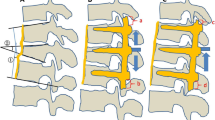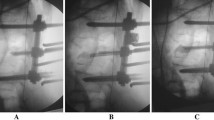Abstract
Introduction
An experimental study of experimental burst fractures in bovine spinal specimens was conducted to analyze the effects of transpedicular short-segment posterior fixation followed by reduction on indirect spinal canal decompression.
Materials and methods
For this purpose, experimental burst fractures were created in 11 bovine specimens with a hydraulic materials-testing machine. The specimens were evaluated with plain radiographs and CT scans before reduction. Thereafter, they were instrumented with titanium transpedicular screws and rods (short-segment posterior fixation); and reduction was achieved which included distraction and kyphosis correction maneuvers.
Results
Each spinal specimen was evaluated with plain radiographs and CT scans after reduction by applying distraction and kyphosis correction maneuvers. Plain radiographic analysis showed that the kyphosis angle and segmental height values improved. Furthermore, CT scans revealed that the spinal canal diameter values improved compared with those before reduction. The differences between before and after reduction in kyphosis angle, segmental height, anterior body compression, and percentage of retropulsion were statistically significant.
Conclusion
Short-segment posterior fixation followed by indirect spinal canal decompression led to an improvement over spinal canal retropulsion in experimental burst fractures. Furthermore, the kyphosis angle and segmental height values improved following the reduction compared with those before reduction.





Similar content being viewed by others
References
Alanay A, Acaroglu E, Yazici M et al (2001) Short-segment pedicle instrumentation of thoracolumbar burst fractures. Does transpedicular intracorporeal grafting prevent early failure? Spine 26:213–247
An HS, Singh K, Vaccaro AR et al (2004) Biomechanical evaluation of contemporary posterior spinal internal fixation configurations in an unstable burst-fracture calf spine model: special references of hook configurations and pedicle screws. Spine 29:257–262
Andress HJ, Braun H, Helmberger T et al (2002) Long-term results after posterior fixation of thoraco-lumbar fractures. Injury Int J Care Injured 33:357–365
Bradford DS, McBride GG (1987) Surgical management of thoracolumbar spine fractures with incomplete neurologic deficits. Clin Orthop 218:201–216
Danisa OA, Shaffrey CI, Jane JA et al (1995) Surgical approaches for the correction of unstable thoracolumbar burst fractures: a retrospective analysis of treatment outcomes. J Neurosurg 83:978–983
Denis F (1983) The three column spine and its significance in the classification of acute thoracolumbar spine injuries. Spine 8:817–831
Dick W, Kluger P, Magerl F et al (1985) A new device for internal fixation of thoracolumbar and lumbar spine fractures: the fixateur interne. Paraplegia 23:225–232
Harris MB (1992) The role of anterior stabilization with instrumentation in the treatment of thoracolumbar burst fractures. Orthopaedics 15:347–350
Kaneda K, Abumi K, Masanori F (1984) Burst fractures with neurologic deficits of the thoracolumbar-lumbar spine, results of anterior decompression and stabilization with anterior instrumentation. Spine 9:788–795
Kostuik JP (1988) Anterior fixation for burst fractures of the thoracic and lumbar spine with or without neurological involvement. Spine 13:286–293
Kramer DI, Rodgers WB, Mansfield FL (1999) Transpedicular instrumentation and short-segment fusion of thoracolumbar fractures: a prospective study using a single instrumentation system. J Orthop Trauma 9:499–506
Mariotti AJ, Diwan AD (2002) Current concepts in anterior surgery for thoracolumbar trauma. Orthop Clin North Am 33:403–412
McLain FR, Sparling E, Benson RD (1993) Early failure of short-segment pedicle instrumentation for thoracolumbar burst fractures. A preliminary report. J Bone Joint Surg Am 75:162–169
Mumford J, Weinstein JN, Spratt KF et al (1993) Thoracolumbar burst fractures: the clinical efficacy and outcome of nonoperative management. Spine 18:955–970
Oda T, Panjabi MM (2001) Pedicle screw adjustments affect stability of thoracolumbar burst fractures. Spine 26:2328–2333
Oda T, Panjabi MM, Kato Y (2001) The effects of pedicle screw adjustments on the anatomical reduction of thoracolumbar burst fractures. Eur Spine J 10:505–511
Oner FC (2002) Posterior instrumentation in spinal fractures. Presented at the 6th International Congress on Spinal Surgery, Ankara
Riley LH III, Eck JC, Yoshida H (2004) A biomechanical comparison of calf versus cadaver lumbar spine models. Spine 29:217–220
Sanderson PL, Fraser RD, Hall DJ et al (1999) Short segment fixation of thoracolumbar burst fractures without fusion. Eur Spine J 8:495–500
Sasso RC, Cotler HB (1993) Posterior instrumentation and fusion for unstable fractures and fracture dislocation of the thoracic and lumbar spine. Spine 18:45–60
Shen WJ, Liu TJ, Shen YS (2001) Nonoperative treatment versus posterior fixation for thoracolumbar junction burst fractures without neurologic deficit. Spine 26:1038–1045
Shono Y, McAfee PC, Cunningham BW (1994) Experimental study of thoracolumbar burst fractures. Spine 19:1711–1722
Weidenbaum M, Farcy JPC (1991) Surgical management of thoracic and lumbar burst fractures. In: Bridwell KH, DeWald RL (eds) Textbook of spinal surgery. JB Lippincott, Philadelphia
Wessberg P, Wang Y, Irstam L et al (2001) The effect of surgery and remodelling on spinal canal measurements after thoracolumbar burst fractures. Eur Spine J 10:55–63
Wilke HJ, Krischak ST (1996) Biomechanical comparison of calf and lumbar spines. J Orthop Res 14:500–503
Author information
Authors and Affiliations
Corresponding author
Additional information
The present study was performed in the Department of Orthopaedics and Traumatology, Cumhuriyet University School of Medicine, and Cumhuriyet University Technical School Laboratory.
Rights and permissions
About this article
Cite this article
Turker, M., Tezeren, G., Tukenmez, M. et al. Indirect spinal canal decompression of vertebral burst fracture in calf model. Arch Orthop Trauma Surg 125, 336–341 (2005). https://doi.org/10.1007/s00402-005-0816-4
Received:
Published:
Issue Date:
DOI: https://doi.org/10.1007/s00402-005-0816-4




